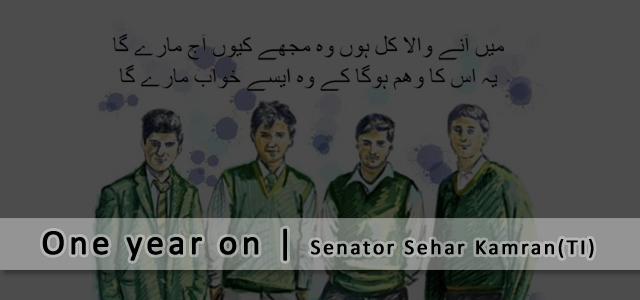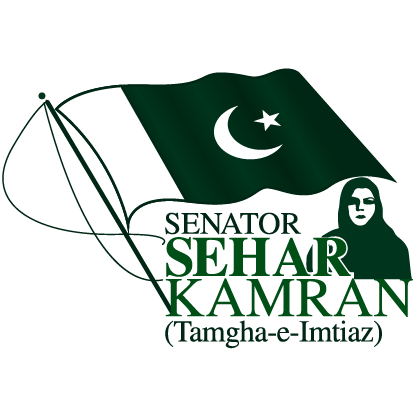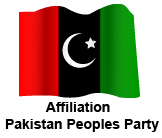By Senator Sehar Kamran (TI)
Dec 17, 2015
 Mein anay wala kal hoon, woh mujhe kyun aaj maray ga?
Mein anay wala kal hoon, woh mujhe kyun aaj maray ga?
Ye us ka weham ho ga ke woh aisay khwaab maray ga
These verses reflect not only the message of hope and strength that resonated across the faces of the survivors of the Army Public School tragedy, but also the resilience that has been demonstrated by APS students since that Black Day in the pages of Pakistan’s history. Since then, these verses have also become the anthem of every child across the nation resolved to ‘rise and shine’ in the face of such base attempts at intimidation by the cowardly peddlers of terror. There is no ambiguity whatsoever that the attacks of December 16, 2014 were an attack not only on the children of Pakistan but on the education system itself, in a bid to derail the country’s future. But there is even lesser uncertainty today, almost a year on from the massacre, of the entire nation’s resolve to stand united and undeterred against such recreant brutality and to continue the pursuit of progress and excellence.
What stands to scrutiny then are the actions of the State of Pakistan to support this resolve and reinforce the protection of its citizens, and the ideals they seek to uphold. In the immediate aftermath of the tragedy at APS, the Prime Minister of Pakistan had summoned an All Parties’ Conference (APC) in Peshawar, in which all political parties had resolved to fight terrorism and build consensus on all issues of national importance. A 20 point ‘Action Plan’ had been drafted, and adopted in the Parliament as the National Action Plan (NAP). While the much hyped document has certainly been in the news since its initiation, unfortunately the goals and targets set therein have remained mostly unattainable. In fact, in July 2015, the Supreme Court of Pakistan itself termed the national counter terrorism strategy as a “plan of inaction”. Senior judge Justice Jawwad S. Khawaja remarked that not ‘a single bit’ of work had been done on the plan, despite the passage of six months. While some progress has been made on some points, many vital aspects of the NAP continue to be ignored.
As the one year anniversary of NAP draws close, there is a flurry of statements by leaders across the political spectrum, all fairly ambiguous as to why the goals set by NAP and unanimously agreed upon continue to remain elusive. Instead of acting as a single cohesive body, the state apparatus appears to have divided into ‘parties’ and ‘blocs’, all bent on protecting themselves and displacing blame over the lack of progress on NAP.
Of the twenty core issues addressed by the NAP, the most important matter that has remained unaddressed and is at the heart of the ineffectiveness of NAP is the activation of the National Counter-Terrorism Authority (NACTA). The organization that was meant to be at the heart of Pakistan’s counter terrorism and violent extremism drive and the central coordination agency remains un-empowered for a multitude of reasons. It has seen five ‘National Coordinators’ in two years, and has a strength of mere 57against the present 300 posts. Furthermore, no funds were included in the budget presented for FY 2015-2016, despite a request for Rs 960 million from the Ministry of Finance for its activation. As a result, the combined deterrence plan and comprehensive response plans envisaged under the National Internal Security Policy (NISP) remain largely un-implemented, and the formation of Joint Intelligence Directorate (JID) distant dream.
Similarly there are many other aspects of the NAP that have received far too little attention over the year, let alone actual enforcement. The fifth of the twenty points, for example, was concerned with literature, newspapers and magazines promoting hatred, decapitation, extremism, sectarianism and intolerance. While some action has certainly been taken against such publications espousing hate through cases registered under the Anti-Terrorism Act of 1997, many more go unchecked as the law remains inadequate to guarantee convictions for the accused in such cases. Many chat rooms and social media channels also continue to freely spread hate speech.
The next point dealt with constraining the finances of terrorist networks by cracking down on funding chains. Most of these outfits however, have already switched to innovative, ‘alternate’ money transfer networks – both ‘hawala’ based and informal – and no longer depend upon regular bank accounts. Worryingly, there is no action plan to combat such alternate mechanisms. For example, according to a study by the Pakistan Peace Collective (PPC), of only the money raised for charity in Pakistan annually, approximately 18 to 20% ends up in the hands of such terrorist organizations; 20% of 550 billion rupees is no small amount.
Furthermore, many defunct groups continue to operate within the country under pseudonyms, notably those with a focus on sectarian activities. Organized street protests, donation drives and control over various madrassas highlight how they are still operating without many checks. Their activities have claimed over 5,000 lives in Pakistan to date.
In this context, the delays in the registration and regulation of religious seminaries are a further problem. The total number of madrassas affiliated with the Wafaq is approximately 28,000, a tiny figure in comparison to the actually functional unregistered seminaries, scores of which escape the scrutiny of the government as they are usually built as an additional room of a mosque. There is no credible information for the number of unregistered madrassas, particularly since they are generally located in remote areas.
Similarly, little has been done to encourage the end of religious extremism and the protection of minorities. Pakistan’s abysmal record of the protection of its minorities and indiscriminate use of laws to persecute them is nothing short of disgraceful.
Little has been done to empower the Baloch government, and certainly no steps have been taken to establish and deploy a dedicated counter-terrorism force. There is still no comprehensive policy to resolve the issue of Afghan refugees. Nothing has been done to reform and empower criminal courts to strengthen anti-terrorism institutions.
Amongst the most commonly cited reasons for this slow progress are the lack of coordination between government Ministers and law enforcement agencies, the misappropriation of funds, an inactive NACTA, the ineffectiveness of the apex committees – when eleven of the fifteen are chaired by one of the already busiest men in the country, what better could be expected – a somewhat tense civil-military relationship and most importantly, the lack of political will.
There is no doubt that 16th December will forever be marked as a Black day in the history of Pakistan, and for more reasons than one. It will be as the ‘day when our spirits were jolted but not broken’. Our forces have since fought bravely and Operation Zarb-e-Azb has offered a much-needed respite from the onslaught of terrorism, but now more than ever, it is the need of the hour that instead of playing the blame game, all stakeholders join hands to eliminate, once and for all, the threats posed to our nation. It is vital for the government to consolidate the gains made by the military, and the political leadership will have to play its part properly if the efforts against counterterrorism are not to go to waste. Terrorists alone cannot break our spirit, especially when we stand united as we do today, but the faith in the State’s counter-terrorism efforts must be restored for this drive to bear fruit.
Today we are honoured to say that we are proud of our forces and the slogan of our children ‘Mujhay dushman ke bachon ko parhana hai’. Let us hope that in this New Year, we may also be able to express similar sentiments for the NAP and in a long-overdue real drive by the Pakistani government to counter terrorism. Pakistan Zindabad.
Same version of the article appeared in The Nation


